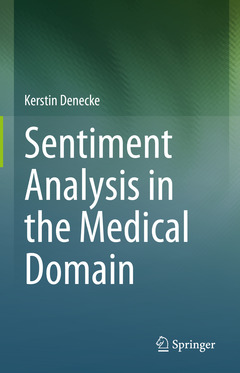Sentiment Analysis in the Medical Domain, 1st ed. 2023
Auteur : Denecke Kerstin

Part I Landscape of medical sentiment
1 What is special about medical sentiment analysis?
1.1 Overview
1.2 Opinion definition
1.3 Definition of medical sentiment
2 Use cases of medical sentiment analysis
2.1 Sentiment analysis in mental health
2.2 Outcome and quality assessment of healthcare services and technologies
2.2.1 Analysis of patient questionnaires
2.2.2 Clinical outcome analysis
2.2.3 Social media as mirror of service quality
2.3 Sentiment analysis for clinical risk prediction2.4 Sentiment analysis for public health
2.5 Sentiment analysis for pharmacovigilance
2.6 Sentiment and emotion analysis in health-related conversational agents
Part II Resources and challenges
3 Medical social media and its characteristics
3.1 Characteristics of medical social media data
3.2 Twitter
3.3 User reviews
3.4 Forums
4 Clinical narratives and their characteristics
4.1 Linguistic characteristics of clinical narratives
4.2 Clinical narratives
.ix x Contents
5 Other data sources5.1 User statements from interaction with intelligent agents
5.2 Other sources
6 Datasets for medical sentiment analysis
6.1 The burden of available datasets
6.2 MIMIC databases
6.3 i2B2 dataset
6.4 TREC dataset
6.5 eDiseases dataset
.6.6 Multimodal Sentiment Analysis Challenge (MuSe)
6.7 General domain datasets
1 7 Lexical resources for medical sentiment analysis
7.1 LIWC
7.2 SentiWordNet and its derivations
7.3 AFINN7.4 EmoLex
7.5 WordNet Affect
7.6 WordNet for Medical Events
7.7 Other sentiment lexicons
7.8 Ontologies and biomedical vocabularies
.Part III Solutions
8 Levels and tasks of sentiment analysis
8.1 Level of analysis
8.1.1 Document-level sentiment analysis
8.1.2 Sentence-level sentiment analysis.
8.1.3 Aspect-level sentiment analysis.
8.2 Tasks within medical sentiment analysis.
8.2.1 Subjectivity analysis.
8.2.2 Polarity analysis.
8.2.3 Intensity classification.
8.2.4 Emotion recognition.
9 Document pre-processing
9.1 Overview
9.2 Data collection and preparation
9.3 Text normalisation.
9.4 Feature extraction.
9.4.1 Bag of words
9.4.2 Distributed representation
9.5 Feature selection. .
9.6 Topic detection.
Contents xi
Lexicon-based medical sentiment analysis.
1 Overview on lexicon-based approaches.
2 Approaches to lexicon generation
achine learning-based sentiment analysis approaches
.1 Unsupervised learning approaches .
.1.1 Partition methods
1.2 Hierarchical clustering methods.
1.2 Supervised approaches
.2.1 Linear approaches
.2.2 Probabilistic approaches.
2.3 Rule-based classifier
.2.4 Decision tree classifier.
.3 Semi-supervised approaches. .
.4 Deep learning approaches
.4.1 Deep neural networks (DNN)
.4.2 Convolutional neural networks (CNN)
.4.3 Long short-term memory (LSTM).
11.5 Hybrid approaches
11.6 Concluding remarks
12 Sentiment analysis tools
12.1 Sentiment: Sentiment Analysis Tool.
12.2 TextBlob
12.3 Pattern for Python.
12.4 Valence Aware Dictionary and Sentiment Reasoner (VADER)
12.5 TensiStrength
12.6 LIWC83
12.7 Other tools
13 Case studies
13.1 Learning about suicidal ideation
13.1.1 The problem
13.1.2 Solution overview13.1.3 Methods and procedures
13.2 Predicting the psychiatric readmission risk
13.2.1 The problem
13.2.2 Solution overview
13.2.3 Methods and procedures
.13.3 Generating a corpus for clinical sentiment analysis
13.3.1 The problem
13.3.2 Solution overview
13.3.3 Methods and procedures.
13.4 Conversational agent with emotion recognition
13.4.1 The problem
xii Contents
13.4.2 Solution overview
13.4.3 Methods and procedures.
13.5 Surveillance of public opinions in times of pandemics
13.5.1 The problem
13.5.2 Solution overview
13.5.3 Methods and procedures.
13.6 Providing quality information about hospitals
13.6.1 The problem
13.6.2 Solution overview
13.6.3 Methods and procedures.
Part IV Future
14 Medical sentiment analysis - Quo vadis?
14.1 SWOT strategy.
14.2 Strengths
14.3 Weaknesses.
14.4 Opportunities
14.5 Threats101 15 Open challenges related to language.
15.1 Specific language phenomena hampering sentiment analysis. .
15.1.1 Negations
15.1.2 Valence shifters
15.1.3 Paraphrasing, sarcasm and irony.
15.1.4 Comparative sentences.
15.1.5 Coordination structures
15.1.6 Word ambiguity.
15.2 Evolution of language
16 Responsible sentiment analysis in healthcare.
16.1 Ethical principles applied to medical sentiment analysis
16.2 Respect for autonomy
16.3 Beneficience and non-maleficience
16.4 Justice
16.5 Explicability and trust
16.6 Concluding remarks
17 Explainable sentiment analysis.
17.1 Definition and need for XAI. .
17.2 Explainable AI methods
17.3 Applications of XAI to medical sentiment analysis
Contents xiii 18 The future of medical sentiment analysis
18.1 Current research gaps in medical sentiment analysis
18.2 Towards domain-specific resources: Lexicons and datasets.
18.3 Addressing domain-specific challenges and increasing accuracy.
18.4 Towards understandable and ethical sentiment analysis.
18.5 Demonstrate the benefit for patient care.
18.6 Concluding remarks
References
Glossary.
Index.
The book allows readers to dive into the research topic of medical sentiment analysis
No such comprehensive overview on this topic is yet available
Strength, weaknesses, opportunities and threats of medical sentiment analysis are described
Date de parution : 05-2023
Ouvrage de 151 p.
15.5x23.5 cm
Disponible chez l'éditeur (délai d'approvisionnement : 15 jours).
Prix indicatif 168,79 €
Ajouter au panier


